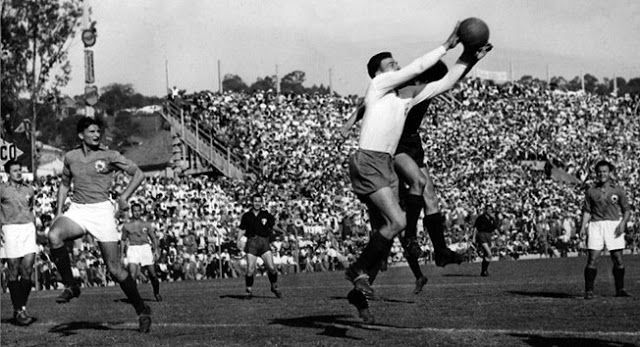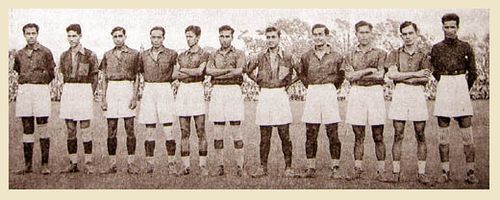
The Football World Cup that almost didn't happen
Brazil will host the 2014 FIFA World Cup next year in what promises to be a carnival of football.
This will be the second time that the country will stage football’s premier competition. In 1950, the fourth edition of the tournament was held in Brazil. Uruguay upstaged the Selecao to lift the trophy, their second overall. However, it was a tournament that almost never happened.
World War II had ensured the cessation of sporting activity around the globe. After Italy had triumphed in 1938, the war had put paid to the 1942 Cup, originally scheduled to be held in Brazil. 1946 also did not see the light of day as Europe continued to be embroiled in war. So, after a gap of 12 years, the competition resumed when FIFA awarded the rights to Brazil. Most of Europe was still recovering from the effects of the war and was in no position to conduct a tournament of that scale.
This edition saw many firsts; it was the first World Cup to be called the Jules Rimet trophy, to mark the 25th anniversary of Rimet’s presidency.
It was also the first time that a round-robin format was used. The 16 teams were divided into four groups and the winner from each group made it into the final four, where they competed against each other in another round-robin scrap.

Two time defending champions Italy, winners in 1934 and 1938, had lost a lot of their players in an air disaster during the war. FIFA, however, were very interested in persuading the Italians to come as a top draw. The Italian federation, though initially hesitant, finally agreed to send it’s players by boat rather than air due to financial constraints. Along with Brazil as hosts, the 2 teams received automatic qualification.
Germany and Japan were barred from competing in the qualifying program as they remained under occupation, post the war. Germany had also undergone partition and the football federations of the newly formed nations had not been formed.
A lot of teams refused to participate, particularly the countries behind the then Iron Hand group, such as the erstwhile USSR, 1934 finalists Hungary and 1938 finalists Czechoslovakia.
In South America, Argentina, Ecuador and Peru withdrew after the qualifying round of games. In Argentina’s case, it was down to a dispute with the Brazilian football federation (CBF).
Due to this, the remaining South American teams automatically qualified and hence Chile, Uruguay, Paraguay and Bolivia all made it through.
Philippines, Burma and Indonesia withdrew from the Asian region and that meant India qualified by default. Austria and Belgium also pulled their teams out citing inexperience and unpreparedness as reasons. This opened the door for Switzerland and Turkey to qualify without even playing their last round of matches.
England finished top of the British qualification group while Scotland finished behind them. The Scots, however, did not make the trip to Brazil in controversial circumstances owing to a commitment made by their Federation Chairman George Graham. Graham, before the start of the qualification process, had insisted that Scotland would take part in the World Cup only if they finished as winners of their home qualifying set up. After the Scots finished second, England captain Billy Wright spoke to his Scottish counterpart George Young to try and convince Graham to change his mind, but he refused to wilt and his decision saw the Scots being denied an opportunity to compete.
Turkey, who had got a free ride into the Cup, pulled out on account of financial reasons and the cost of travelling to South America. To cover for the slots left vacant by the withdrawal of Turkey and Scotland, FIFA invited France and Portugal to take part. Portugal declined, but the French accepted and were included in the draw for the 1950 World Cup.

Had things gone right, India could have played in the 1950 World Cup
After the draw was completed and the four pools identified, the Indian Football association, the AIFF, decided against sending its team to the World Cup citing travel expenses, lack of preparation and team selection issues, though FIFA had agreed to bear a major part of the travel expenses. India had played barefoot in the 1948 Olympics, leading to FIFA subsequently banning barefoot play. The then Indian captain Shailen Manna, though, claimed that the reasons offered by the AIFF were a screen meant to cover up the real reasons behind the association’s backing out.
France also pulled out due to the amount of travel that they would have to undertake during their group matches, bearing in mind the financial and logistical difficulties involved. And since their withdrawal came late, there wasn’t enough time to call in replacements. Hence, the tournament began with just 13 teams instead of the intended 16.

The first round saw the teams split into 4 pools of 4 teams each. The number was ultimately reduced to 13 due to the various pull-outs. The increased number of games under the new format was meant to generate more revenue in an attempt to recover significant investments made on stadiums and facilities by the Brazilian authorities. England came into the competition as one of the favorites, but were dumped out early as they were shocked 1-0 by the USA and also lost to Spain by an identical score line. Defending champions Italy suffered their first ever World Cup loss when they were beaten by Sweden 3-2. As a result, they too failed to progress into the final knock-out.

Powerhouses Brazil along with Spain, Sweden and inaugural champions of the 1930 World Cup Uruguay progressed to the final four. Brazil were the favorites to take home the Cup, and the feeling was amplified after they thumped Sweden 7-1 and Spain 6-1. They went into their final game needing just a draw to win the World Cup on home soil. On July 16, at the iconic ‘Estadio do Maracana’ in front of a massive capacity crowd of an estimated 205,000, they faced Uruguay in the final match of the tournament. The hosts even took the lead 2 minutes into the second half and it looked like going to plan, and the home crowd were ready for a grand celebration. Then came the equalizer and more was to follow as with 11 minutes left, Alcides Ghiggia scored a second for the Uruguayans which turned out to be the game winner. Unbridled joy turned to despair for the Brazilian players and the fans, as things went pear shaped after starting so well. This match, when the mighty ‘Selecao’ were upset, came to be known as the ‘Maracanazo’ (in Portuguese, roughly translates to ‘the Maracana Blow’). The word, since, is a slang for when an underdog team upsets the Brazilian national team or when a small club upsets one of the ‘Big Four’ of Vasco da Gama, Flamengo, Fluminense and Botafogo.
Football had been brought back on the world stage and sport was instrumental in reviving nations and international ties post the casualties of war. The first World Cup after the war, the ‘Campeonato Mundial de Futebol’, was a sporting success, but it was a World Cup that almost wasn’t.